Now is the perfect time to get your garden in place for the summer. I wanted to build a simple planter box that I can use to grow a few vegetables this year.
As with many projects, I started with a design in Sketchup. It is a simple design, so anyone can make it, and it uses simple fencing materials that can be found at your local big box store. If you want to follow along, check out the free downloadable plans on my website! While you are there, be sure to check out some of the other projects and plans I have as well.
#1: Building the Base
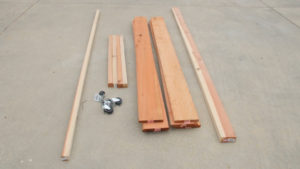 I’m using redwood for this project because it is naturally rot and insect resistant. Because I’m going to be planting vegetables, I also did not want to use pressure or chemically treated lumber that could affect the soil. Redwood is easy to get in California where I live, but if you don’t have access to it, another rot-resistant wood like cedar is a good alternative.
I’m using redwood for this project because it is naturally rot and insect resistant. Because I’m going to be planting vegetables, I also did not want to use pressure or chemically treated lumber that could affect the soil. Redwood is easy to get in California where I live, but if you don’t have access to it, another rot-resistant wood like cedar is a good alternative.
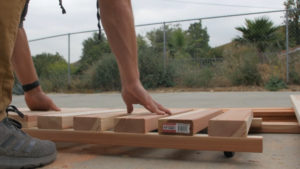 I cut a couple of redwood 2 by 4’s and spaced them out using redwood balusters. Then I screwed them together with exterior decking screws. Next I added some 2″ swiveling casters to the base, because I want to be able to move this garden around. I’m not sure where I want it to live long term. Being able to move it around is important to me, and the wheels make it unique.
I cut a couple of redwood 2 by 4’s and spaced them out using redwood balusters. Then I screwed them together with exterior decking screws. Next I added some 2″ swiveling casters to the base, because I want to be able to move this garden around. I’m not sure where I want it to live long term. Being able to move it around is important to me, and the wheels make it unique.
Once it is all put together, you won’t be able to see the wheels easily either.
#2: Creating the Box
 With the base complete, I added the balusters that will act as the uprights in the corners. Before adding the fence pickets, I also added some wire mesh to the base to help support the soil and protect it from critters.
With the base complete, I added the balusters that will act as the uprights in the corners. Before adding the fence pickets, I also added some wire mesh to the base to help support the soil and protect it from critters.
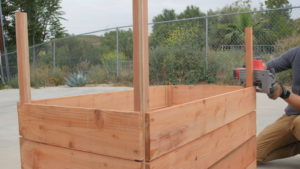 I began adding the picket fencing to the sides. I cut each one at 4′ long and used the remaining piece on the sides. Using my carpenter’s pencil, I ensured there was a 1/4″ space between each. The lowest course should fall 3/4″ off the ground which will help obscure the wheels. This is also enough space to push the box along an uneven hard surface.
I began adding the picket fencing to the sides. I cut each one at 4′ long and used the remaining piece on the sides. Using my carpenter’s pencil, I ensured there was a 1/4″ space between each. The lowest course should fall 3/4″ off the ground which will help obscure the wheels. This is also enough space to push the box along an uneven hard surface.
Once all 4 courses were installed, I cut off the excess uprights.
#3: The Finishing Touches
I added some weed fabric to the bottom to ensure water doesn’t rot the inside of the box. It is water permeable, but I poked some holes in the bottom to add better drainage at the bottom. You could also use thick plastic if you wanted. The redwood is naturally rot resistant, so I don’t mind having it weather naturally.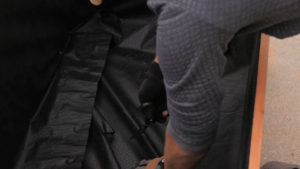
Next I added some additional fence pickets to dress up the corners of the box. I simply butted two pieces together and screwed them together at 90 degree angles. Then I attached those to the corners. To finish off, I’m going to add a mitered frame to the top.
 For this frame, I added a 2 1/2″ lip around the outside which give a nice work surface. This adds a nice work surface without intruding on the planting area too much. Finally, I just need to add my vegetables, and this project is complete.
For this frame, I added a 2 1/2″ lip around the outside which give a nice work surface. This adds a nice work surface without intruding on the planting area too much. Finally, I just need to add my vegetables, and this project is complete.
I’m really happy with how this planter box turned out. It’s pretty big and heavy, but being able to move it is really cool. The only thing I might add next time is a cage over the top to protect it from animals, but I’ll tackle that down the road if I need to.
I hope you all liked this project. Again, if you want more detailed measurements and step-by-step instructions, please check out the free downloadable plans on my website. Please feel free to leave a comment to let me know what you thought or if you have ideas for some other projects I could do!
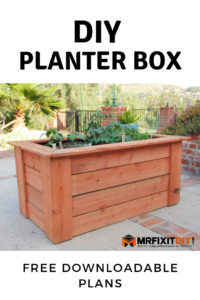
Thank you guys so much, and I’ll see you next time!
If you enjoyed this project, here are a few other projects you might enjoy.










[…] Download Plan More @ http://www.mrfixitdiy.com […]
[…] Download Plan More @ http://www.mrfixitdiy.com […]
[…] Download Plan More @ http://www.mrfixitdiy.com […]
Comments are closed.